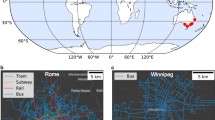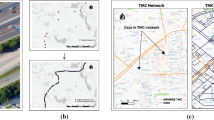Abstract
The creation of the General Transit Feed Specification (GTFS) in the mid-2000s provided a new data format for cities to organize and share digital information on their public transport systems. GTFS feeds store geolocated data on public transport networks, including information on routes, stops, timetables, and service levels. The GTFS standard is now widely adopted by thousands of transport authorities and a wide variety of software applications for different purposes, including trip planning, timetable creation and accessibility analysis. Yet, there is still a lack of tools to parse GTFS data when the objective is to analyze the complex spatial and temporal patterns of public transport systems. This paper presents {gtfs2gps}, a new general-purpose computational tool to easily process static GTFS data that allows one to analyze the space–time trajectories of public transport vehicles at fine spatial and temporal resolutions. {gtfs2gps} is an open-source R package that employs parallel computing to convert GTFS feeds from relational text files into a trajectory data table, similar to GPS records, with the timestamps of vehicles in every trip. This paper explains the package functionalities and demonstrates how {gtfs2gps} can be used to articulate key concepts in time geography to explore and visualize the spatial and temporal patterns of public transport networks. We also present a case study looking at how {gtfs2gps} can be used to examine socioeconomic and spatial–temporal inequalities in access to public transport, providing key information to monitor cities’ progress toward the Sustainable Development Goals. The paper is accompanied by a computational notebook in R Markdown to support reproducibility of the results in this paper and to replicate the analysis for other contexts where GTFS data are available. Given the widespread use of GTFS, {gtfs2gps} opens new possibilities for researchers to examine the time geography of public transport systems in urban areas across the globe.





Similar content being viewed by others
Notes
GTFS feeds of several cities can be downloaded from repositories such as https://www.transit.land or https://transitfeeds.com.
References
Antrim A, Barbeau SJ (2017) Opening the door to multimodal applications: creation, maintenance and application of GTFS data (No 17-03702). Article 17–03702. Transportation research board 96th annual meeting transportation research board. https://trid.trb.org/view/1438473
Arbex R, Cunha CB (2020) Estimating the influence of crowding and travel time variability on accessibility to jobs in a large public transport network using smart card big data. J Transp Geogr 85:102671. https://doi.org/10.1016/j.jtrangeo.2020.102671
Arribas-Bel D, Alvanides S, Batty M, Crooks A, See L, Wolf L (2021) Urban data/code: a new EP-B section. Environ Plan: Urban Anal City Sci 48(9):2517–2519. https://doi.org/10.1177/23998083211059670
Banister D (2002) Transport planning (2 edition.). London u.a.: Spon: Routledge
Brunsdon C, Comber A (2021) Opening practice: supporting reproducibility and critical spatial data science. J Geogr Syst 23:477–496. https://doi.org/10.1007/s10109-020-00334-2
Charleux L (2015) A modification of the time-geographic framework to support temporal flexibility in ‘fixed’ activities. Int J Geogr Inf Sci 29(7):1125–1143. https://doi.org/10.1080/13658816.2015.1009464
Dardas A, Hall B, Salter J, Hosseini H (2022) A geospatial workflow for the assessment of public transit system performance using near real-time data. Trans GIS 26(4):1642–1664. https://doi.org/10.1111/tgis.12942
Demšar U, Buchin K, Cagnacci F, Safi K, Speckmann B, Van de Weghe N, Weiskopf D, Weibel R (2015) Analysis and visualisation of movement: an interdisciplinary review. Mov Ecol 3(1):5. https://doi.org/10.1186/s40462-015-0032-y
Hägerstrand T (1970) What about people in regional science? Pap Reg Sci Assoc 24(1):6–21. https://doi.org/10.1007/BF01936872
Herszenhut D, Pereira RHM, Andrade PR, Bazzo J (2021) gtfstools: general transit feed specification (GTFS) editing and analysing tools (1.0.0.9) [R]. R Found Stat Comput. https://doi.org/10.5281/zenodo.5703236
Holden E, Linnerud K, Banister D, Wierling A (2018) The imperatives of sustainable development: needs, justice, limits. Routledge, Taylor & Francis Group, London
Kwan M-P (2000) Interactive geovisualization of activity-travel patterns using three-dimensional geographical information systems: a methodological exploration with a large data set. Transp Res Part c: Emerg Technol 8(1–6):185–203
Kwan M-P (2004) GIS methods in time-geographic research: geocomputation and geovisualization of human activity patterns. Geogr Ann: Ser B Hum Geogr 86(4):267–280
Lee J, Miller HJ (2018) Measuring the impacts of new public transit services on space-time accessibility: an analysis of transit system redesign and new bus rapid transit in Columbus, Ohio, USA. Appl Geogr 93:47–63. https://doi.org/10.1016/j.apgeog.2018.02.012
Lee J, Miller HJ (2020) Robust accessibility: Measuring accessibility based on travelers’ heterogeneous strategies for managing travel time uncertainty. J Transp Geogr 86:102747. https://doi.org/10.1016/j.jtrangeo.2020.102747
Long JA, Nelson TA (2013) A review of quantitative methods for movement data. Int J Geogr Inf Sci 27(2):292–318. https://doi.org/10.1080/13658816.2012.682578
Lovelace R (2021) Open source tools for geographic analysis in transport planning. J Geogr Syst. https://doi.org/10.1007/s10109-020-00342-2
Lucas K, Mattioli G, Verlinghieri E, Guzman A (2016) Transport poverty and its adverse social consequences. Proc Inst Civil Eng: Transp 169(6):353–365. https://doi.org/10.1680/jtran.15.00073
Miller HJ (2005) A Measurement theory for time geography. Geogr Anal 37(1):17–45. https://doi.org/10.1111/j.1538-4632.2005.00575.x
Miller HJ (2017) Time geography and space–time prism. Int Encycl Geogr: People Earth Environ Technol 1–19
Morgan M, Young M, Lovelace R, Layik H (2021) Opentripplanner for R: setup and connect to “OpenTripPlanner” (0.4.0.99999) [R]. R Found Stat Comput, https://zenodo.org/record/3558311
Neutens T, Schwanen T, Witlox F (2011) The prism of everyday life: towards a new research agenda for time geography. Transp Rev 31(1):25–47. https://doi.org/10.1080/01441647.2010.484153
Páez A (2021) Open spatial sciences: an introduction. J Geogr Syst 23:467–476. https://doi.org/10.1007/s10109-021-00364-4
Pandey A, Lehe L, Monzer D (2021) Distributions of bus stop spacings in the United States. Findings. https://doi.org/10.32866/001c.27373
Pereira RHM, Karner A (2021) Transportation equity. In: Vickerman R (ed) International encyclopedia of transportation, vol 1. Elsevier Ltd, United Kingdom, pp 271–277
Pereira RHM, Saraiva M, Herszenhut D, Braga CKV, Conway MW (2021) r5r: rapid realistic routing on multimodal transport networks with R5 in R. Transp Find. https://doi.org/10.32866/001c.21262
Pereira RHM, Schwanen T (2015) Commute time in Brazil (1992–2009): differences between metropolitan areas, by income levels and gender. Discussion Paper No. 192. Ipea, Institute for Applied Economic Research. https://repositorio.ipea.gov.br/bitstream/11058/5140/1/DiscussionPaper_192.pdf
Poletti F, Herszenhut D, Buckley T, Padgham M, Noriega-Goodwin D (2021) tidytransit: read, validate, analyze, and map GTFS feeds (1.2.0) [R]. R Found Stat Comput, https://github.com/r-transit/tidytransit
Rey SJ (2009) Show me the code: spatial analysis and open source. J Geogr Syst 11(2):191–207. https://doi.org/10.1007/s10109-009-0086-8
Singleton A, Arribas-Bel D (2021) Geographic data science. Geogr Anal 53(1):61–75. https://doi.org/10.1111/gean.12194
Song Y, Miller HJ (2012) Exploring traffic flow databases using space–time plots and data cubes. Transportation 39(2):215–234. https://doi.org/10.1007/s11116-011-9343-z
Sui D (2012) Looking through Hägerstrand’s dual vistas: towards a unifying framework for time geography. J Transp Geogr 23:5–16. https://doi.org/10.1016/j.jtrangeo.2012.03.020
UN-Habitat (2018) SDG 11+ metadata: a guide to assist national and local governments to monitor and report on SDG goal 11+ indicators; UN-Habitat: Nairobi, Kenya. https://www.local2030.org/library/60/SDG-Goal-11-Monitoring-Framework-A-guide-to-assist-national-and-local-governments-to-monitor-and-report-on-SDG-goal-11-indicators.pdf
United Nations U.N. (2015) Transforming the World: the 2030 agenda for sustainable development; United nations general assembly; United Nations, New York
Wessel N, Allen J, Farber S (2017) Constructing a routable retrospective transit timetable from a real-time vehicle location feed and GTFS. J Transp Geogr 62:92–97. https://doi.org/10.1016/j.jtrangeo.2017.04.012
Wolf LJ, Fox S, Harris R, Johnston R, Jones K, Manley D, Tranos E, Wang WW (2021) Quantitative geography III: future challenges and challenging futures. Prog Hum Geogr 45(3):596–608. https://doi.org/10.1177/0309132520924722
Wu H, Levinson D (2021) Optimum stop spacing for accessibility. Eur J Transp Infrastruct Res 21(2):1–18. https://doi.org/10.18757/ejtir.2021.21.2.4794
Yang L, Kwan M-P, Pan X, Wan B, Zhou S (2017) Scalable space-time trajectory cube for path-finding: a study using big taxi trajectory data. Transp Res Part B: Methodol 101:1–27. https://doi.org/10.1016/j.trb.2017.03.010
Yang L, Zhang F, Kwan M-P, Wang K, Zuo Z, Xia S, Zhang Z, Zhao X (2020) Space-time demand cube for spatial-temporal coverage optimization model of shared bicycle system: a study using big bike GPS data. J Transp Geogr 88:102861. https://doi.org/10.1016/j.jtrangeo.2020.102861
Author information
Authors and Affiliations
Corresponding author
Additional information
Publisher's Note
Springer Nature remains neutral with regard to jurisdictional claims in published maps and institutional affiliations.
Rights and permissions
Springer Nature or its licensor (e.g. a society or other partner) holds exclusive rights to this article under a publishing agreement with the author(s) or other rightsholder(s); author self-archiving of the accepted manuscript version of this article is solely governed by the terms of such publishing agreement and applicable law.
About this article
Cite this article
Pereira, R.H.M., Andrade, P.R. & Vieira, J.P.B. Exploring the time geography of public transport networks with the gtfs2gps package. J Geogr Syst 25, 453–466 (2023). https://doi.org/10.1007/s10109-022-00400-x
Received:
Accepted:
Published:
Issue Date:
DOI: https://doi.org/10.1007/s10109-022-00400-x




